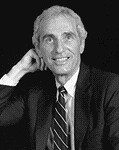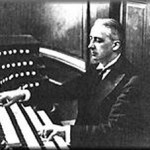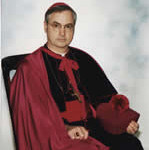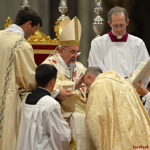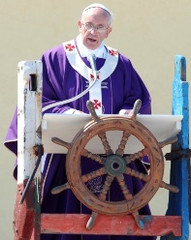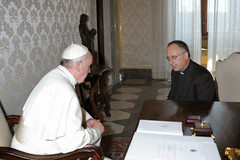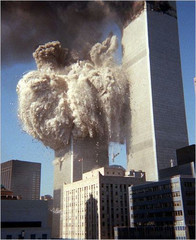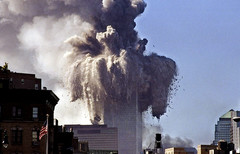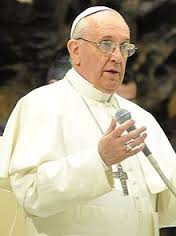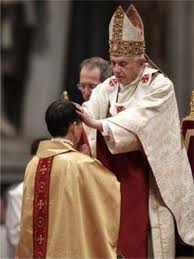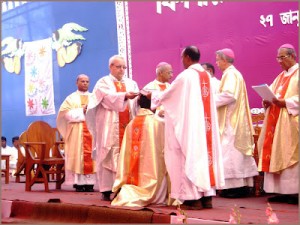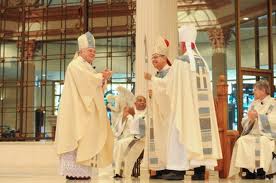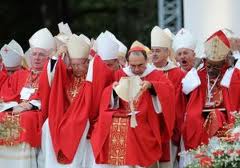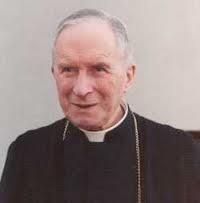 NOTE FROM FR. CEKADA: In discussions on various forums, I’ve noticed that many SSPX supporters can’t bring themselves to believe that Abp. Lefebvre EVER said ANYTHING that favored sedevacantism, implying in bargain that SSPX sede old-timers like myself are are either liars or delusional.
NOTE FROM FR. CEKADA: In discussions on various forums, I’ve noticed that many SSPX supporters can’t bring themselves to believe that Abp. Lefebvre EVER said ANYTHING that favored sedevacantism, implying in bargain that SSPX sede old-timers like myself are are either liars or delusional.
Below is an article by John Daly which provides a nice selection of the Archbishop’s “pro-sede” quotes. I think it is time for SSPX loyalists to put aside the false ideas they have been fed about Abp. Lefebvre as the great anti-sede.
Since this is a rather long article, I have taken the liberty of putting into bold some passages in the quotes from Abp Lefebvre.
————————————-
ARCHBISHOP LEFEBVRE AND SEDEVACANTISM
by John Daly
(Four Marks, 2006)
So far as we know, Archbishop Lefebvre never formed a definite judgment that John-Paul II was not a true pope. So if we divide the ecclesiastical spectrum into two categories, those for whom the see is legally vacant and those for whom it is legally occupied, Archbishop Lefebvre will be in the non-sedevacantist camp.
But such divisions are not always helpful. If we divide the animal kingdom between bipeds and the rest we shall find ourselves misleadingly close to the turkeys. Other criteria of evaluation exist. Did Archbishop Lefebvre admit that sedevacantists might well be right? Did he consider them to be upright members of the Church? Did he avow that his persevering recognition of John-Paul II was due more to heroically cautious hesitation than to any solid conviction? Did he envisage declaring the vacancy of the Holy See if the situation continued unchanged? Did he insist that settling the question of whether the Vatican II “popes” were truly popes or not was an important duty, not to be evaded? Did he hold that Vatican II was unequivocally schismatic? Did he hold that Vatican II was unequivocally heretical? Did he believe it impossible to interpret Vatican II in an orthodox sense? Did he reject outright all the conciliar reforms? Did he declare that Vatican II had founded a new, false and schismatic religion? Did he deny that the members of the new Vatican II Church were Catholics? Did he doubt the validity of the new rites of Mass, ordination and episcopal consecration? Did he hold that John-Paul II and his henchmen were already excommunicated? Did he rejoice to be separated from the Church of John-Paul II? Did he consciously employ sedevacantist seminary professors at Ecône, ordain and assign ministries to sedevacantist clergy, and send his seminarians to gain pastoral experience with a sedevacantist priest?
You may find it surprising, even bewildering, but the answer to all the above questions is “yes”, as we shall shortly see. But it should first be emphasised that we are not studying Archbishop Lefebvre’s convictions in order to accept them as necessarily sound and judicious in every respect. Nor do we deny that other apparently contradictory texts may be cited from him on many of these points. The interest of the late prelate’s attitude to the Conciliar Church lies elsewhere. We shall come back to that subject after having shown that the Archbishop did indeed express the views we attribute to him. To do this we shall repeat the above questions, allowing the Archbishop’s own words and deeds to answer them.
Did Archbishop Lefebvre admit that sedevacantists might well be right?
1. “You know, for some time, many people, the sedevacantists, have been saying, ‘there is no more pope’. But I think that for me it was not yet the time to say that, because it was not sure, it was not evident…” (Talk, March 30 and April 18, 1986, text published in The Angelus, July 1986)
2. “The question is therefore definitive: is Paul VI, has Paul VI ever been, the successor of Peter? If the reply is negative: Paul VI has never been, or no longer is, pope, our attitude will be that of sede vacante periods, which would simplify the problem. Some theologians say that this is the case, relying on the statements of theologians of the past, approved by the Church, who have studied the problem of the heretical pope, the schismatic pope or the pope who in practice abandons his charge of supreme Pastor. It is not impossible that this hypothesis will one day be confirmed by the Church.” (Ecône, February 24, 1977, Answers to Various Burning Questions)
Did he frequently and respectfully allude to the sedevacantist explanation of the crisis?
1. “To whatever extent the pope departed from…tradition he would become schismatic, he would breach with the Church. Theologians such as Saint Bellarmine, Cajetan, Cardinal Journet and many others have studied this possibility. So it is not something inconceivable.” (Le Figaro, August 4, 1976)
2. “Heresy, schism, ipso facto excommunication, invalidity of election are so many reasons why a pope might in fact never have been pope or might no longer be one. In this, obviously very exceptional case, the Church would be in a situation similar to that which prevails after the death of a Pontiff.” (Le Figaro, August 4, 1976)
3. “…these recent acts of the Pope and bishops, with protestants, Animists and Jews, are they not an active participation in non-catholic worship as explained by Canon Naz on Canon 1258§1? In which case I cannot see how it is possible to say that the pope is not suspect of heresy, and if he continues, he is a heretic, a public heretic. That is the teaching of the Church.” (Talk, March 30 and April 18, 1986, text published in The Angelus, July 1986)
4. “It seems inconceivable that a successor of Peter could fail in some way to transmit the Truth which he must transmit, for he cannot – without as it were disappearing from the papal line – not transmit what the popes have always transmitted.” (Homily, Ecône, September 18, 1977)
5. “If it happened that the pope was no longer the servant of the truth, he would no longer be pope.” (Homily preached at Lille, August 29, 1976, before a crowd of some 12,000)
Did he consider sedevacantists to be upright members of the Church?
Undoubtedly. He rebuked certain over-zealous Society priests who refused the sacraments to sedevacantists. He collaborated with Bishop de Castro-Mayer after the Brazilian prelate had made his sedevacantism quite clear. He accepted numerous seminarians from sedevacantist families, parishes or groups. He patronised the Le Trévoux “Ordo” with its guide to traditional places of worship throughout the world, which has always included (and still does) certain known sedevacantist Mass centres. He was at all times well aware of the presence of sedevacantists among the Society’s priests.
Did he avow that his persevering recognition of Paul VI and John-Paul II was due more to heroically cautious hesitation than to any solid conviction?
1. “While we are certain that the faith the Church has taught for 20 centuries cannot contain error, we are much further from absolute certitude that the pope is truly pope.” (Le Figaro, August 4, 1976)
2. “It is possible we may be obliged to believe this pope is not pope. For twenty years Mgr de Castro Mayer and I preferred to wait…I think we are waiting for the famous meeting in Assisi, if God allows it.” (Talk, March 30 and April 18, 1986, published in The Angelus, July 1986)
3. “I don’t know if the time has come to say that the pope is a heretic (…) Perhaps after this famous meeting of Assisi, perhaps we must say that the pope is a heretic, is apostate. Now I don’t wish yet to say it formally and solemnly, but it seems at first sight that it is impossible for a pope to be formally and publicly heretical. (…) So it is possible we may be obliged to believe this pope is not pope.” (Talk, March 30 and April 18, 1986, text published in The Angelus, July 1986)
Did he envisage declaring the legal vacancy of the Holy See if the situation continued unchanged?
1. “That is why I beseech Your Eminence to …do everything in your power to get us a Pope, a true Pope, successor of Peter, in line with his predecessors, the firm and watchful guardian of the deposit of faith. The…eighty-year-old cardinals have a strict right to present themselves at the Conclave, and their enforced absence will necessarily raise the question of the validity of the election” (Letter to an unnamed cardinal, August 8, 1978.)
2. “It is impossible for Rome to remain indefinitely outside Tradition. It’s impossible… For the moment they are in rupture with their predecessors. This is impossible. They are no longer in the Catholic Church.” (Retreat Conference, September 4, 1987, Ecône)
Did he insist that settling the question of whether the Vatican II “popes” were truly popes or not was an important duty, not to be evaded?
1. “…a grave problem confronts the conscience and the faith of all Catholics since the beginning of Paul VI’s pontificate: how can a pope who is truly successor of Peter, to whom the assistance of the Holy Ghost has been promised, preside over the most radical and far-reaching destruction of the Church ever known, in so short a time, beyond what any heresiarch has ever achieved? This question must one day be answered…” (Le Figaro, August 4, 1976)
2. “Now some priests (even some priests in the Society) say that we Catholics need not worry about what is happening in the Vatican; we have the true sacraments, the true Mass, the true doctrine, so why worry about whether the pope is heretic or an impostor or whatever; it is of no importance to us. But I think that is not true. If any man is important in the Church it is the pope.” (Talk, March 30 and April 18, 1986, text published in The Angelus, July 1986)
Did he hold that Vatican II was unequivocally schismatic?
“We believe we can affirm, purely by internal and external criticism of Vatican II, i.e. by analysing the texts and studying the Council’s ins and outs, that by turning its back on tradition and breaking with the Church of the past, it is a schismatic council.” (Le Figaro, August 4, 1976)
Did he hold that Vatican II was unequivocally heretical?
In an interview with Mr Tom Chapman’s Catholic Crusader in 1984 the Archbishop expressly characterised the decree on Ecumenism (Unitatis Redintegratio) as “heretical”.
Did he believe it impossible to interpret Vatican II in an orthodox sense?
“Do you agree to accept the Council as a whole? Reply: Ah, not religious liberty – it isn’t possible!” ((Retreat Conference, September 4, 1987, Ecône. The Archbishop’s words imagine the kind of interrogation his seminarians would have been submitted to if he had accepted the terms of agreement John-Paul II was offering him, entailing a Cardinal-Visitor entitled to grant or refuse the ordination of seminarians. The reply is the reply he assumes his seminarians would have to make and he goes on to explain that such a reply would have enabled the Cardinal-Visitor to refuse the seminarian’s ordination – his reason for refusing the deal.)
Did he reject outright all the conciliar reforms?
“We consider as null…all the post-conciliar reforms, and all the acts of Rome accomplished in this impiety.” (Joint Declaration with Bishop de Castro Mayer following Assisi, December 2, 1986)
Did he say that Vatican II and its “popes” had founded a new, false and schismatic religion?
1. “It is not we who are in schism but the Conciliar Church.” (Homily preached at Lille, August 29, 1976, before a crowd of some 12,000 – these words appear in the original un-corrected version of the sermon as recorded and reported in the press)
2. “Rome has lost the Faith, my dear friends. Rome is in apostasy. These are not words in the air. It is the truth. Rome is in apostasy… They have left the Church… This is sure, sure, sure.” (Retreat Conference, September 4, 1987, Ecône)
3. John Paul II “now continually diffuses the principles of a false religion, which has for its result a general apostasy.” (Preface to Giulio Tam’s Osservatore Romano 1990, contributed by the Archbishop just three weeks before his death)
Was he forthright in stating that the Conciliar Church is not the Catholic Church?
1. “This Council represents, in our view and in the view of the Roman authorities, a new Church which they call the Conciliar Church.” (Le Figaro, August 4, 1976)
2. “The Church which affirms such errors is both schismatic and heretical. This Conciliar Church is therefore not Catholic.” (July 29, 1976, Reflections on the Suspension a divinis)
Did he deny that the members of the new Vatican II Church were Catholics?
1. “To whatever extent pope, bishops, priests or faithful adhere to this new Church, they separate themselves from the Catholic Church.” (July 29, 1976, Reflections on the Suspension a divinis)
2. “To be publicly associated with the sanction [of excommunication] would be a mark of honour and a sign of orthodoxy before the faithful, who have a strict right to know that the priests they approach are not in communion with a counterfeit Church…” (Open Letter to Cardinal Gantin, July 6, 1988, signed by 24 SSPX superiors, doubtless with Archbishop Lefebvre’s approval)
Did he question the validity of the new rites of Mass, ordination and episcopal consecration?
1. “This union which liberal Catholics want between the Church and the Revolution is an adulterous union – adulterous. This adulterous union can only beget bastards. Where are these bastards? They are [the new] rites. The [new] rite of Mass is a bastard rite. The sacraments are bastard sacraments. We no longer know whether they are sacraments that give grace. We no longer know if this Mass gives us the Body and the Blood of Our Lord Jesus Christ. (…) The priests emerging from the seminaries are bastard priests.” (Homily preached at Lille, August 29, 1976, before a crowd of some 12,000.)
2. “If we think that this reformed liturgy is heretical and invalid, whether because of modifications made in the matter and form or because of the reformers’ intention inscribed in the new rite in opposition to the intention of the catholic Church, evidently we cannot participate in these reformed rites because we should be taking part in a sacrilegious act. This opinion is founded on serious reasons…” (Ecône, February 24, 1977, Answers to Various Burning Questions)
3. “The radical and extensive changes made in the Roman Rite of the Holy Sacrifice of the Mass and their resemblance to the modifications made by Luther oblige Catholics who remain loyal to their faith to question the validity of this new rite. Who better than the Reverend Father Guérard des Lauriers to make an informed contribution to resolving this problem…?” (Foreword contributed to a book in favour of the thesis of invalidity by Fr Guérard des Lauriers. Écône, February 2, 1977)
4. Moreover Archbishop Lefebvre personally conditionally re-ordained many priests who had been ordained in the 1968 rite and re-confirmed those purportedly confirmed in the new rite or by the new bishops.
Did he hold that John-Paul II and his henchmen were excommunicated “antichrists”?
1. “So we are [to be] excommunicated by Modernists, by people who have been condemned by previous popes. So what can that really do? We are condemned by men who are themselves condemned…” (Press conference, Ecône, June 15 1988)
2. Post-consecration statement (Summer 1988), SSPX school Bitsche, Alsace-Lorraine: “the archbishop stated, going even beyond even his 15th June press conference, that those who had excommunicated him had themselves long been excommunicated.” (Summary in the Counter-Reformation Association’s, News and Views, Candlemas 1996)
3. “The See of Peter and the posts of authority in Rome being occupied by antichrists, the destruction of the Kingdom of Our Lord is being rapidly carried out even within His Mystical Body here below (…) This is what has brought down upon our heads persecution by the Rome of the antichrists.” (Letter to the future bishops, 29 August 1987)
Did he rejoice to be separated from the Church of John-Paul II?
1. “We have been suspended a divinis by the Conciliar Church and from the Conciliar Church, to which we have no wish to belong.” (July 29 1976, Reflections on the Suspension a divinis)
2. “…we do not belong to this religion. We do not accept this new religion. We belong to the old religion, the Catholic religion, not to this universal religion as it is called today. It is no longer the Catholic religion…” (Sermon, June 29, 1976)
3. “I should be very happy to be excommunicated from this Conciliar Church… It is a Church that I do not recognize. I belong to the Catholic Church.” (Interview July 30 1976, published in Minute, no. 747)
4. “We have never wished to belong to this system that calls itself the Conciliar Church. To be excommunicated by a decree of your eminence…would be the irrefutable proof that we do not. We ask for nothing better than to be declared ex communione…excluded from impious communion with infidels.” (Open Letter to Cardinal Gantin, July 6, 1988, signed by 24 leading SSPX priests, doubtless with Archbishop Lefebvre’s approval)
Did he consciously employ a sedevacantist seminary professor at Ecône, ordain and assign ministries to sedevacantist clergy, and send his seminarians to gain pastoral experience with a sedevacantist priest at his month-long summer camp each year?
He did indeed. We shall not run the risk of setting the poursuivants on the heels of those involved by naming persons who in many cases are still sedevacantist and still members of the SSPX or in collaboration with it. Any priest who was at Ecône in the days of the Archbishop will confirm our answer.
********************************************************************
The above quotations and facts point to a hard-line Lefebvre, very close to sedevacantism, rejecting outright Vatican II, the new sacraments and doctrines and communion with the leaders of the new pseudo-Catholic religion. But it is only honest to grant that that is only half of the story. Other words and deeds of the Archbishop would give a strikingly different impression.
It would be idle to debate which was the real Archbishop Lefebvre. The plain fact is that the Archbishop wavered. Unswerving on the fact that a new and false religion has been founded, he hesitates as to whether the pope of the new religion can also be head of the Catholic Church. Particular outrages provoke a strong reaction on his part: the suspension of 1976, the 1985 Synod, the 1986 Assisi jamboree of false religions, the 1988 excommunication – all bring him to the very brink of the explicit statement that those responsible cannot be popes. Close contact with men such as Fr. Guérard des Lauriers and Bishop de Castro Mayer, and with books such as that of Arnaldo Xavier de Silveira, encourage him towards such a declaration. Poised to plunge, he hesitates…and retreats.
We cannot justly force the facts in order to make Archbishop Lefebvre into a sedevacantist, for he was not one, but we can justly and respectfully draw several interesting conclusions from our texts and others too lengthy to quote in this article.
1. From 1975-8, and from 1985 until his death, Archbishop Lefebvre was not hostile to sedevacantism as such and seems to have accorded it the status of what theologians would call a “probable opinion”. He often came close to sharing this opinion, never pretended to be able to refute it outright, and he recognised that it might well one day become sufficiently clear for him to accept it firmly.
2. Not even the Archbishop’s most fervent admirers could claim that his statements bearing on recent papal claimants were always clear, firm and consistent or that they displayed detailed knowledge of the relevant theology and Canon Law.
3. Though aware of the classic “heretical pope” controversy among theologians, the Archbishop does not seem at any stage to have made a serious study of the nature of heresy, its effects and its recognition. He even thought that the extreme liberalism of Paul VI and John-Paul II was in some sense a defence against the charge of heresy. He meant that their minds were too full of heretical ideas for them to be insincere in believing these ideas to be orthodox. It does not seem to have occurred to him that such a “defence” would have been equally available to the likes of Lammenais and Loisy.
4. He was confident of his competence to recognise and denounce the heresies of Modernism and Liberalism, but he was conscious of lacking the theological formation necessary to be able to evaluate the status of the Johns and the Pauls, the difficulty the crisis poses with regard to the Church’s indefectibility and the infallibility of the Ordinary and Universal Magisterium.
5. His seminary training at the French College in Rome under the celebrated Père le Floch had vaccinated him forever against Liberalism in all its shapes. His ecclesiastical career had prepared him for organisation and for diplomacy. But neither had made him a specialist theologian or given him any notion of being one. This is apparent in his rôle of defender of tradition at the Council and afterwards: he organises and negotiates with skill, but he is uncertain in the theological evaluation of previously unimaginable events. He had relied heavily – and for very good reason – upon his profoundly learned and saintly theological adviser Fr Victor-Alain Berto, responsible for many of the Archbishop’s interventions at Vatican II, but Berto had died in 1968, succumbing to the anguish of the Vatican II apostasy. Lefebvre was never again to find an adviser he could so fully trust, even when he stood in most need of one.
6. Archbishop Lefebvre’s nominal recognition of Paul VI and his successors was explicitly presented as being a provisional position. Those who have erected it into an immutable dogma are thus unfaithful to the Archbishop.
7. Archbishop Lefebvre was highly optimistic in the early years of John-Paul II and it was in those years that he was most trenchant in his anti-sedevacantist words and deeds. Yet even then he never expelled any priest from his Society for private sedevacantism and only twice for even public sedevacantism in the absence of other issues. His general policy was to persuade sedevacantist priests to remain. And with the 1985 Synod and Assisi in 1986 he was disabused of his illusion that “Pole” could be made to rhyme with “Pope”.
8. No one can be sure that, if Archbishop Lefebvre were alive today, he would not be a sedevacantist. No one can be sure that he would be one either. But one thing that seems highly improbable is that he would have adopted the anodyne style of Bishop Fellay and the ruling left-wing of the Society for whom in our days expressions such as “excommunicated antichrists” is more likely to be an allusion to sedevacantists than to the apparent occupant of the Roman See. And another equally improbable notion is that he would have been deceived into taking Josef Ratzinger, whom he cordially detested, for a sincere friend of traditional Catholicism.
9. It is possible to sympathise with the Archbishop’s plight as he contemplated, alone, the very grave ecclesiological aspect of the crisis – the aspect which he felt unable to make up his mind about; indeed it would be heartless not to sympathise. Defend the faith, assure the continuity of the priesthood and the availability of the sacraments to the faithful, but leave “on hold” the difficult question of the status of the soul-murderers in the Vatican: however much we may regret it, that is at least a comprehensible policy. Certain glib young sedevacantists of our days, with no gift of hindsight and quick to attribute blame, clearly cannot imagine the weight of responsibility felt by the Archbishop as he contemplated, trembling, the enormity of what sedevacantism implied.
10. What seems much harder to countenance is the consequent policy of pragmatism by which a position the Archbishop himself was not sure of became officially obligatory in the Society in order to maintain unity and streamline the Society’s apostolate. Like all men, priests need to be able to converse freely with their peers about their concerns and their doubts, without fear of denunciation for “thought-crime” and possible sanctions. The Archbishop failed to provide this facility and it still does not exist in the SSPX. One consequence is the weakness of character of many SSPX priests – inevitable outcome of a sectarian training. Another is the massive defection rate from the Society: some have become sedevacantists, some have accepted the indult, some have gone independent, some have gone off to “marry” and some have succumbed to nervous breakdowns – all bear witness to the Society’s internal stress problem.
We have seen that there is no truth in the mythology according to which Archbishop Lefebvre had a firm and consistent policy of recognising the Vatican II popes, sternly and consistently rejecting sedevacantism as a solidly refuted error. On the contrary, the Archbishop often expressed views so hard-line that today no SSPX priest or seminarian would dare say anything similar for fear of expulsion! The mythology is due to the fact that the Archbishop fluctuated and hesitated, leaving on the record words and acts enabling him to be invoked both by the liberal and by the hard-line camps. Indeed his fluctuations and hesitations were on a scale such as to be tolerated only because of the great personal veneration which the mass of traditional Catholic faithful felt for the Archbishop himself. And today the Society no longer has any prominent member whose personality or ecclesiastical status are comparable to those of the Archbishop. Thus the Society’s need for credibility requires it to show more consistency than the Archbishop himself did, while continuing to invoke his authority for decisions that no one can feel any confidence he would have endorsed.
Let us be candid about the origins of this situation. The SSPX’s independent traditionalist apostolate was originally intended only as a provisional succour for a temporary need. Understandably no one foresaw the length of the crisis. Emergency measures sometimes have to be undertaken before there is time for a full theological evaluation of the need that calls for them. But there can be no lasting and effective apostolate which is not firmly founded on theology. This does not mean merely that effective apostles must have an adequate formation in theology, though that is true. It means that the basis, nature, actions and aims of their apostolate itself must also be theologically determined. This is not and never has been the case of the SSPX, because the Archbishop’s legacy to the Society he founded did not include any ecclesiology of the Conciliar Church’s relation to the Catholic Church. The SSPX malaise will continue until this omission is fully rectified, if that is possible.
And that malaise cannot be denied. A quarter of a century ago, the SSPX was swamped with vocations, had a high level of priestly loyalty and was in a position to contrast its success with the manifestly miserable state of the Modernist seminaries and clergy. Everyone knows that the gloating has stopped. Fewer vocations, very high drop-out and expulsion rates in the seminaries, numerous priestly defections in every direction, scant sign of a theological élite among the Society’s clergy, the toleration of priests infected with the innovative itch, high second-generation lay lapsation rates even among those schooled in the Society’s own schools – the sad tale is undeniable and things are not getting any better. Meanwhile, the Society is losing the theological debate not only with sedevacantism but also with the indult groups, who have shown a remarkable drawing power and a surprising ability to produce a learned and thoughtful clergy.
For the SSPX publicly and formally to declare the vacancy of the Holy See would require a miracle and doing so would not suffice to cure the malaise we have pointed to.
But it is perhaps not completely unrealistic to wonder whether the Society’s authorities might not one day explicitly avow that sedevacantism is at least a theologically probable opinion and encourage polite and open debate about the sedevacantist thesis among priests and faithful within the Society and outside. It would not perhaps be incurably optimistic to hope that the Society’s sedevacantist priests and collaborators might be allowed to be frank about their convictions. A statement might be made pointing out that in any discussions with occupied Rome, Benedict XVI can place nothing worth having on his side of the negotiating table except the remote prospect of his own conversion to the Catholic Faith which he has spent the greater part of his life destroying. While we are daydreaming, we could imagine collaboration between SSPX priests and such sedevacantist priests as might be appropriate and willing. We could add the expulsion of the Society’s ultra-liberal fifth column – beginning with Fr. Grégoire Célier – and what about publicly disowning Fr. Boulet’s absurdly ignorant anti-sedevacantist pamphlet which finds it necessary to quote falsified history and theology from a book on the Index of Forbidden Books in order to defend what its author believes to be the party line? Nor could anyone reasonably object to the formal study of Bellarmine’s De Romano Pontifice on the dogmatic theology syllabus.
It cannot seriously be doubted that such measures would be sound in theology, a relief to many of the Society’s priests and faithful and would strengthen the Society’s ability to answer the objections made to it from Conciliar quarters. Nor would there be any difficulty in invoking Archbishop Lefebvre’s authority in favour of such initiatives. Above all, there should be the consideration that truth is more important than pragmatism and that its courageous profession earns the blessing of God.
© John Daly 2006
 SINCE THE ELECTION of Jorge Bergoglio (“Pope Francis”) by the March 2013 conclave, more and more Catholics have started to wonder whether the sedevacantist explanation for the state of affairs in the post-Vatican II church might not indeed be the correct one. After all, how can you reconcile the countless outrageous public statements that Bergoglio has made (no Catholic God, who am I to judge, doctrinal security is not possible, proselytism is nonsense, etc.) with the claim that he is indeed the true Successor of Peter? On the face of it, you can’t.
SINCE THE ELECTION of Jorge Bergoglio (“Pope Francis”) by the March 2013 conclave, more and more Catholics have started to wonder whether the sedevacantist explanation for the state of affairs in the post-Vatican II church might not indeed be the correct one. After all, how can you reconcile the countless outrageous public statements that Bergoglio has made (no Catholic God, who am I to judge, doctrinal security is not possible, proselytism is nonsense, etc.) with the claim that he is indeed the true Successor of Peter? On the face of it, you can’t.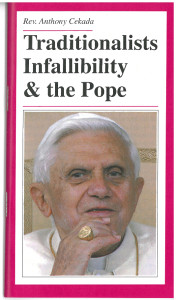 2. Links to Essential Reading
2. Links to Essential Reading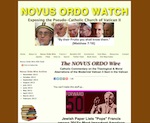 5. Bergoglio News Updates
5. Bergoglio News Updates